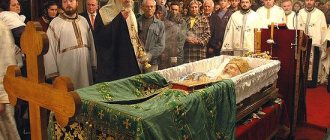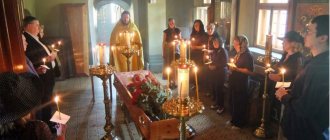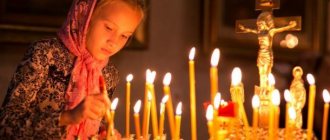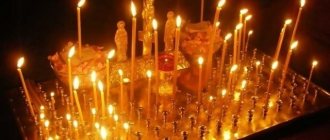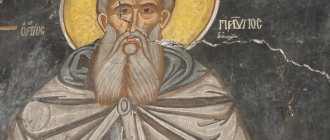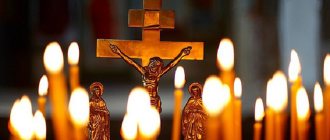Testament of St. Peter Mogila (how to remember deceased parents)
The priests had a dream that they would dig up the coffin with the body of St. Peter. They gathered and, after praying, decided to do so. Saint Peter, rising from the tomb, wrote this instruction-teaching and, returning to the tomb, again went to the Kingdom of Heaven. Amen.
And the one who reads twenty (20) psalters, twenty (20) canons about the repose during the year, and every Saturday, at mass, serves in the Church a prosphora about the repose of the souls of his parents, then no matter how sinful the soul may be, he will be delivered from darkness and torment, and will be taken to the Land of God's light.
A person who does not forget his parents, by the grace of God, with his mercy and the prayers of our Holy Orthodox Church, who delivered their suffering souls from the wrath of hell, is already here, in this life, will never have any need and at the end of his earthly journey will inherit the Kingdom of Heaven. Amen.
Remembrance of the Dead
In the Name of the Father and the Son and the Holy Spirit. Amen. Blessing of the Lord from the holy martyrs Anthony, John and Euthophius. May grace and peace be with you, dear spiritual children and benefactors. I am writing to you about departed souls, I ask you to preserve this value.
• During the three (3) Liturgies, when they are served for the souls of the departed, the Angels of God pray before the Throne of God. They ask for God's mercy; They ask the Lord to command the Angel to enter hell and sprinkle the sinful soul with holy water. • Three more (3) Liturgies – Angels pray and implore the Lord, and the Lord blesses His Angel to give communion and lead the sinful soul to freedom. The angel takes the particles, flies and plunges into the depths of hell, scorching its wings, and brings Holy Communion to the unfortunate soul. • Ten (10) more services – Angels ask the Lord for the command to bring the sinful soul to the gates of hell. • At the twentieth (20) service, the Lord blesses to bring the soul to freedom. • At the twenty-fifth (25) service – Angels brought out black souls, burnt brands. • At the thirtieth (30) service - again the Angel sprinkled the burnt souls with holy water, breathed and said to them: “Cover your bones with human flesh and skin, and enter into yourself.” • At the thirty-fifth (35) service – the Angel of God brought clean linen, clothes and clothed them in light clothes. • At the thirty-sixth (36) service – an Angel of God led them to the doors of Paradise. • At the thirty-eighth (38) service - An angel led them to the Throne of God. The Angel of God, with all the pure souls, fell prostrate before the Throne of the Almighty and thanked the Lord for His mercy, as they were taught by the Holy Spirit. For two days the souls stood before the Throne of Our Lord - they rejoiced, cried, prayed, thanked their relatives for not forgetting them on earth, and promised the Lord to pray for them. The Lord thanked His Angels and blessed the souls of the departed. • At the fortieth (40) service – the Lord said: “By His Mercy and the prayers of Our Holy
Churches, those now living on earth save the souls of their dead relatives from the fire of hell. Four tribes and three tribes of the earth will be saved for your mercy towards your dead relatives, and they will be brought into the abodes of Paradise.” And the Lord also said to His Angel:
“Inhabit these souls in the abodes of heaven, and hand over the keys to the abodes prepared for their merciful descendants who are still on earth to the souls of their relatives, freed from eternal torment, for safekeeping until the time when they too come at My command.”
And when the Angels of God, having handed the keys to the souls of the saved, led them into the heavenly abodes, then all the Heavenly Ones exclaimed with great joy: “Rejoice, people, and be merry!” Amen.
Dear children, help your loved ones, save them from eternal fire and the torments of hell. Whoever serves for forty masses has no one in the abyss. The Lord said: “Whoever saves will themselves be saved.”
God! Bless and enlighten a person. Most Holy Theotokos save us! from the Seraphim-Sarovsky Foundation
Ancient Roman necropolis under the Vatican and the tomb of St. Peter
There are hundreds and thousands of interesting places around me. There are many not only new countries around, but also cities that I just can’t get to (but I want to). However, I have one great love - Italy. I don’t even know how it happened. After all, the point is not even that most of the world's heritage is concentrated there. And it’s not that this is the center of the great Roman Empire. Maybe everything turned out this way because of the inner spirit with which I found myself in this amazing country over and over again? Having visited “Italy in Miniature” in Rimini last fall, I realized how much I had not seen. And that I can’t watch everything again. But despite the vast expanses of the country, there are cities where I have been more than once, and where I will return more than once. Two cities - Venice and Rome.
Once again I found myself in Rome at the beginning of March. Just for three days, but with a clear plan of what I want to see. I formed a clear plan after Diana Kleiner’s wonderful course on Roman architecture, after listening to which, I began to look at the remains of Roman forums with much greater interest, understanding and recognizing their details. At the same time, from her lectures I learned about new, rarely visited objects. Among other things, Diana mentioned the ancient Roman necropolis, located directly under the Vatican's St. Peter's Basilica. Archaeologists have excavated an entire underground street, with tombs on the right and left sides - I had to see it!
| St. Peter's Cathedral and the necropolis street below it. It can be seen that the necropolis was once located on a hill - its base goes up. Picture from here. |
Getting there, however, turned out to be not so easy. Basic information on how to do this (in English) is on the official website of the ufficio scavi - the excavation office. There you can also find a link to a site with a virtual tour of the dungeons, where you can walk by clicking on the arrows (you just need to wait patiently until the Vatican uncle tells you something like that for a couple of minutes). To see the underground tombs, you must write a letter to the ufficio scavi in advance with possible visiting dates. I wrote a letter to them in Italian, but I think you can easily write it in English - they send the answer in both languages. They respond quite quickly - literally the next day I received an email asking me to confirm and pay for my reservation. This letter already indicated a specific date and time (I was given the earliest, 9 am). I wrote in almost six months, but it seems like about a month is enough - two weeks is definitely needed. This pleasure costs 13 euros per person. I don’t know if I need to pay right away or if I can wait a few days. Since I was sure that I wanted to go there, I did not delay payment and paid by card as soon as I received the letter. After payment, I received a letter first about the reservation, and then about the preliminary confirmation of the visit. Two weeks before the day of the visit, I received another confirmation letter (which, however, did not differ in text from the first).
The letters said a lot about all sorts of rules, for example, that you can’t carry any bulky things, and you can’t take cameras either, that you need to be dressed appropriately, and so on. However, there was clearly not enough information about where and how to go. Arriving at the square in front of St. Peter's Cathedral, we doubted where we should go next. It was clear that the entrance should be either on the right or on the left. Since the queue to the cathedral traditionally snaked on the right, we moved to the left. It was still unclear where exactly to go, so I walked briskly towards the Swiss guards in the colorful uniform designed by Raphael. The guardsman saluted and, taking my printed piece of paper confirming the visit, finally satisfied my curiosity and told me where to go. It turned out that the passage was on the right side of the left colonnade. In front of the fence separating the colonnade from the internal Vatican territory, there was an X-ray machine, the guard at which lets you in exactly 15 or 10 minutes before the visit. We arrived at the right time, walked calmly with our camera and a small backpack (we didn’t have to hand it in anywhere, and there was nowhere to go), and found ourselves in a crowd of tourists just like us. Leaving behind those who were at 9-15, we walked forward to the office that was mentioned in the booking confirmation.
| The territory of the Vatican, where entry is prohibited to mere mortals. wikimapia claims that this building is a sacristy and treasury. |
At the office, after presenting our reservation and ID, we received a ticket and at the same time bought several postcards. There were also a couple of books sold there, I just don’t remember whether they were in English or only in Italian. Keep in mind that if you want to buy something, you need to do it right away, since you will not return here, and images of the necropolis are unlikely to be found anywhere else.
| View of St. Peter's Cathedral from the inside out. |
After walking around for some more time and taking pictures of St. Peter's Cathedral from an unusual angle, we finally waited for the guide and went inside. Unfortunately, it was impossible to take photographs inside, so all further photographs from the dungeons were taken from the Internet.
Having passed through the hall with a model of the cathedral and I don’t remember what reliefs hung on the walls, we went down a narrow staircase and found ourselves on the underground street of an ancient Roman cemetery. It should be noted that then, in the distant second century AD, the street was not underground, but rather was in the open air.
| Picture from here. |
The graves in the small excavated area are mostly pagan. You can’t go anywhere, but you can look through glass almost everywhere. In some places, paintings and reliefs have been preserved; urns once stood in niches on the walls. The photo shows the mausoleum of Tulli and Caetenni, excavated in 1941. In the center is a funeral altar.
| Tomb F. Picture from here. |
The mosaic on the floor depicts Mercury and Pluto. On the walls there are images of peacocks and other decorations.
| Tomb I. Picture from here. |
The largest mausoleum, the Valeri Mausoleum, was built in the second half of the 2nd century, during the time of Marcus Aurelius.
| Tomb H. Picture from here. |
In later tombs one can find Christian symbolism disguised as pagan imagery. For example, this mosaic from Tomb M is said to depict Christ as the sun god Helios. In the same tomb there are images of a fisherman with fish and Jonah with a whale.
| Tomb M. Picture. |
How did it happen that an entire cemetery ended up underground? Emperor Constantine is to blame for everything, the same one who moved the capital of the Roman Empire to Constantinople, and under whom Christianity received state support. Constantine wished to build a basilica on the hill where the cemetery was located. Why here? For a very simple reason - according to legend, not far from this place in 66, St. Peter was crucified in the Circus of Nero, and it was on this hill that he was buried. So, in 326, the first church of St. Peter was built. To build it, it was necessary to level the hill and destroy the pagan necropolis. The emperor promised that despite the construction, the tombs would not be destroyed, so they were simply covered with earth, although in some places the roof was destroyed. They fell asleep and forgot. In the 16th century, Pope Julius II ordered the construction of a new cathedral on the site of the Basilica of Constantine. It was built, as usual, for a long time, and with the participation of many architects. The legend that the altar of the cathedral was located above the burial place of Peter continued to flourish, but there was no confirmation of it. Everything changed in 1939, when work began on the construction of the tomb of Pius XI, who asked to be buried next to the supposed tomb of St. Peter. The workers came across brickwork built in pre-Constantine times. It turned out that the masonry belonged to one of the tombs. The new Pope Pius XII ordered the excavations to continue, hoping to find Peter's grave itself. The task was not an easy one - after all, it was necessary to carry out work under the floor of a gigantic functioning temple. As a result, what we can see today - about 20 tombs - is only a small part of the ancient Roman heritage, and the rest remains hidden in the rocks.
The street of ancient pagan tombs ends in the Holy of Holies of the Vatican. The supposed burial place of St. Peter is just two parallel walls, between which his body was allegedly lowered. However, no remains were found in the grave. Initially there was no monument to mark the burial place. Only later did a funerary monument appear - the aedicule, which entered intact into the altar of the first temple of Constantine. What about the remains? They were found in a later wall, simply piled up. The question of whether they belong to the Apostle Peter remained open for many years. However, after a long study of the graffiti wall located next to the aedicule, Margherita Guardacci, an expert on early Christian inscriptions, stated that one of the inscriptions means “Peter is here” in Greek, from which they concluded that these were the remains of St. Peter. Not everyone agrees with this point of view, but in 1968 the Vatican officially recognized the tomb of St. Peter and his remains.
Just like that, unexpectedly, wanting only to look at the ancient Roman tombs, I also saw the relics of the first Pope, after whom my hometown is named.
The tour ends under the floor of the cathedral, in the papal tomb. So we also looked at the papal sarcophagi (for which we would otherwise have to pay separate fees), and climbed into the cathedral itself next to Bernini’s famous canopy, avoiding the need to stand in a long line.
If you want to know more about St. Peter's Tomb, you can take a look at this article about the Rome of the Apostles.
